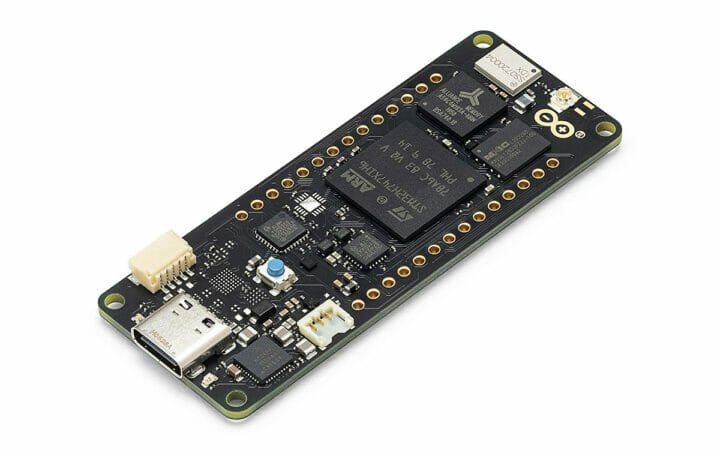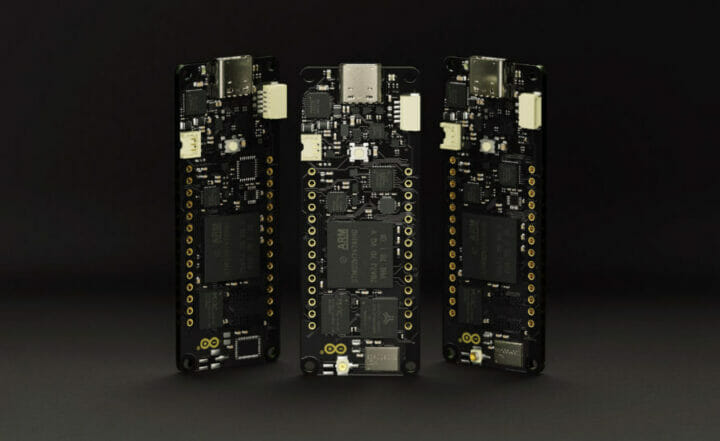Arduino has launched another Arduino Pro board! Well, sort of. Let’s not get too excited. The Portenta H7 Lite Connected is based on last month’s Portenta H7 Lite that itself was a cost-optimized version of Portenta H7 board without a wireless module, USB-C video output, and only fitted with the lower cost Microchip ATECC608 secure element.
Portenta H7 Lite Connected is exactly the same board, except it brings back the Murata 1DX module with 2.4GHz 802.11b/g/n WiFI 4 and Bluetooth 5.1 BR/EDR/LE connectivity, plus the related u.FL antenna connector.
 Portenta H7 Lite Connected specifications:
Portenta H7 Lite Connected specifications:
- Microcontroller – STMicro STM32H747XI Cortex-M7 @ 480 MHz + M4 @ 200 MHz MCU with 2MB dual-bank Flash memory, 1 MB RAM, Chrom-ART graphical hardware accelerator
- System Memory – 2MB SDRAM (upgradeable up to 64MB)
- Storage – 16MB QSPI NOR Flash (Upgradeable up to 128MB)
- Connectivity
- 2.4GHz WiFi 802.11b/g/n up to 65 Mbps and Bluetooth 5.1 BR/EDR/LE via Murata 1DX module
- On-board 10/100M PHY
- Video I/F – MIPI DSI & 8-bit camera interfaces via 80-pin expansion connector
- USB – 1x USB 2.0 Type-C port for power (PD) and programming
- I/Os
- Arduino MKR headers with UART1, 6x Analog input pins, GPIO, PWM, SPI, I2C, Reset, 5V, 3.3V, and GND
- 2x 80 pin high-density connectors
- Storage – SD card signals
- Connectivity – 10/100M Ethernet
- Display – 2-lane MIPI DSI
- Camera – 8-pin camera Interface up to 80 MHz
- Audio – I2S, DMIC, SAI
- USB – 2x USB 2.0 interfaces
- Serial – 4x UART ports (2 with flow control), CAN bus (Tx/Rx)
- 2x I2C, SPI
- 8× ADC pins with 16-bit max. resolution
- 2× 12-bit DAC (@ 1 MHz)
- 6x GPIO and 10x PWM
- Debug – SWD interface
- 5-pin I2C ESLOV connector with 1.0mm pitch
- 3.3V operating voltage
- Security – Microchip ATECC608 secure element
- Misc – 22x timers and watchdogs
- Power Supply
- 5V via USB-C port or VIN pin
- Support for 3.7V/700mAH minimum LiPo single-cell battery; integrated charger
- Consumption – 2.95 μA in Standby mode (Backup SRAM OFF, RTC/LSE ON)
- Temperature Range – -40 °C to +85 °C

Software support will be exactly the same as other Portenta H7 boards with programming using Arduino or MicroPython, as well as TensorFlow Lite for AI applications. The board sells for $98.40/82 Euros which compares to $72/60 Euros for the Lite version, and $103.4/89.90 Euros for the full version with video output via USB-C and NXP secure element. That means the wireless module adds 16.4 dollars or 12 Euros to the cost.
We’ll see if Arduino plans to release a “new” Portenta H7 version every month. With two remaining months to go before the end of the year, I could perfectly envision a “Portenta H7 Lite Connected Secure+” board adding NXP SE0502 crypto chip in November, and a “Portenta H7 Ultra” with 64MB RAM and 128MB SPI NOR flash in December ;).

Jean-Luc started CNX Software in 2010 as a part-time endeavor, before quitting his job as a software engineering manager, and starting to write daily news, and reviews full time later in 2011.
Support CNX Software! Donate via cryptocurrencies, become a Patron on Patreon, or purchase goods on Amazon or Aliexpress





That’s just insanely expensive for what you get.
If they want a Teensy, why don’t they just work with Paul? He manages to make better boards for less even in small volumes.
(Also,somethingisbrokenasIcan’ttypespaces,Ihavetogobackandeditthemin!)(Also,also,thereareatonmorewebsitesrequestingscriptingthanusual!)
Testing comments with space…
What is going on here?
Let’s see! Yay! fixed.
..was my first thought..
Once again, what is the point of using STM32H7 when i.MX RT can do all this for less and faster?
Availability?